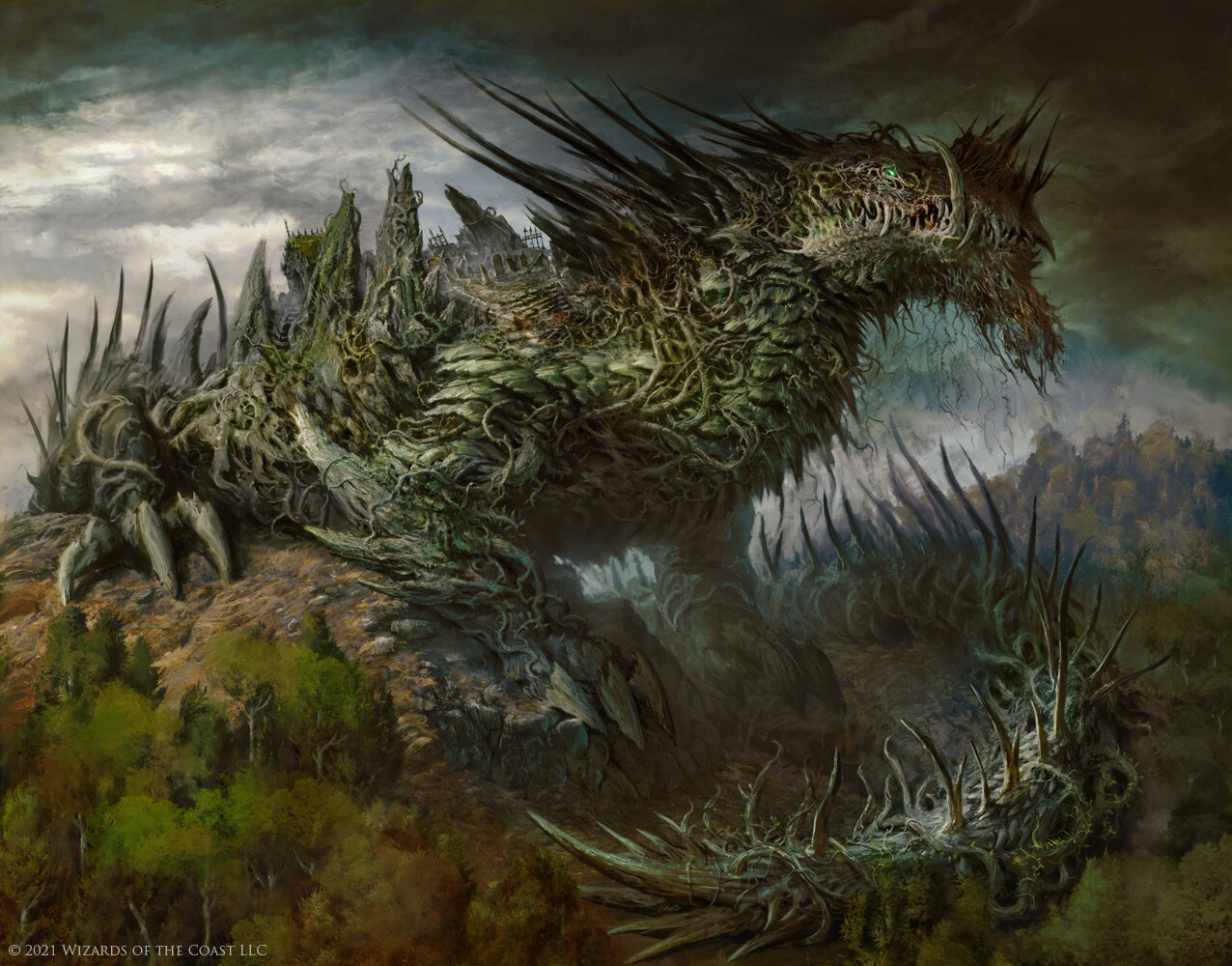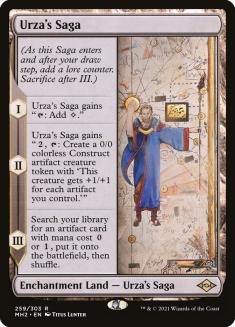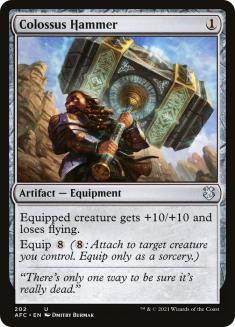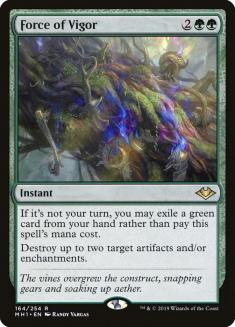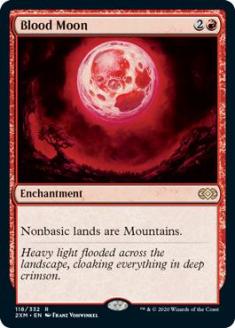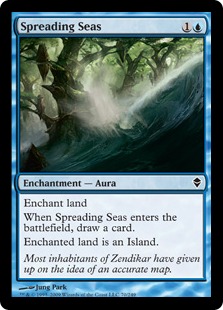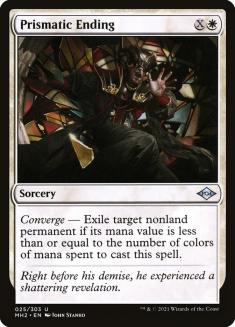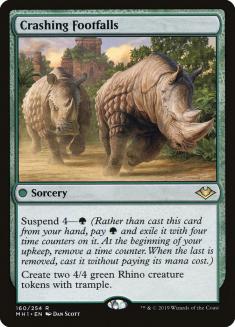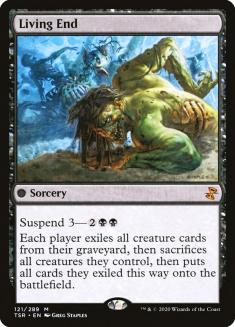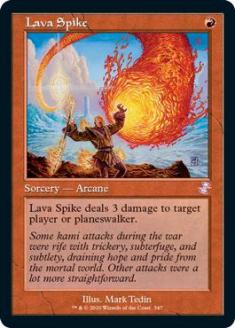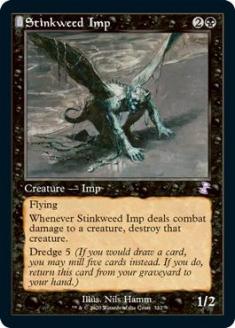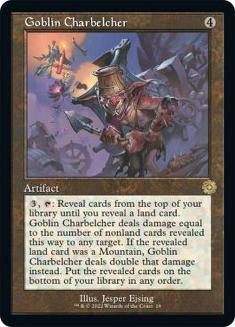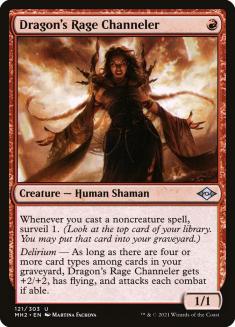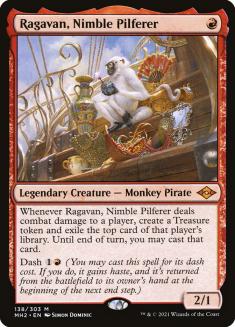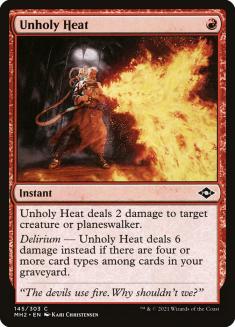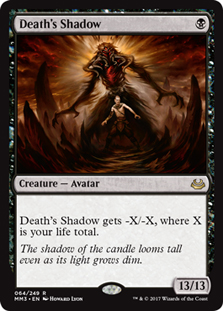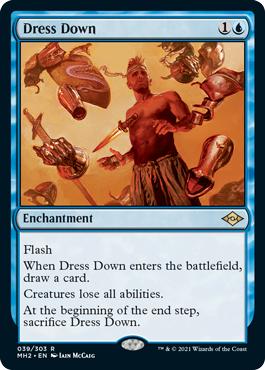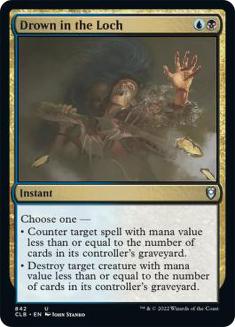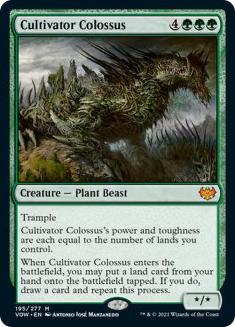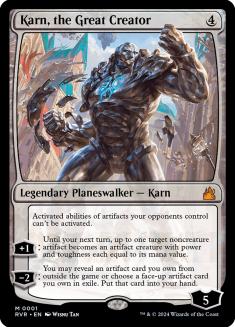In a fast-moving Modern format, everything that’s old is new again. Amulet Titan went from outsider to top dog (yet again!) before completely vanishing — all in the space of a few weeks. If recent results are anything to go by, Amulet Titan is back and better than ever (…until it isn’t?).
I’m no fair-weather Amulet Titan fan — I’ve stuck by it even when I shouldn’t! Modern looked completely different back in March, but Amulet Titan was mostly the same and the big-picture lessons from my deep dive then still apply. Ari and I took an extensive look at the deck’s history as well as what you need to know about it right now on last week’s episode of Dominaria’s Judgment and that’s a useful companion piece for this. Here, I’ll look at the evolution of the format with Modern Horizons 2 from the perspective of an Amulet Titan player to explain why it’s back and how it stacks up against the format at large.
Urza’s Saga was the first card we saw from Modern Horizons 2 and the first sign of a possible Amulet Titan restoration. The deck relies on and leans into Saga less than many other decks — it has no Shadowspear to help Constructs across the finish line and no trinkets like Pithing Needle to fill yet another toolbox — but that’s partly because you enjoy the privilege of Saga finding your namesake card. There’s a world of difference between draws with and without Amulet. Saga gives you guaranteed, if delayed, access to your least replaceable enabler. This delay is significant — a Turn 3 Amulet off Saga needs more additional ramp to set up Primeval Titan on that turn compared to the natural curve of Turn 1 Amulet into Turn 2 Azusa, Lost but Seeking or Dryad of the Ilysian Grove — but the rest of the deck is built with that in mind.
Beyond enabling these ideal draws, Saga fixes a wide range of problems for Amulet Titan. Threat density has always been a limiting factor for the deck and none of the alternate threats or additional ways to find Primeval Titan were convincing (other than Once Upon a Time, the main reason for the deck’s renewed dominance after Throne of Eldraine). Urza’s Saga is a source of threats now and a convoluted way to dig up a Titan via Expedition Map for Tolaria West later. A deck this reliant on resolving a single big spell is inherently susceptible to discard or counterspells; Saga shrugs off all of that. Against other Saga decks, your main plan goes way over the top of a pair of Constructs and there’s no single card you care about from the final chapter (versus the threat of Saga finding Tormod’s Crypt or the like against your graveyard deck).
The best Urza’s Saga deck would automatically have a strong claim to being the best deck in Modern and Mono-White Hammer (Lurrus) quickly earned both titles. This seemed like a bad sign for Amulet Titan, but the outlook improved once we collectively understood more about Hammer and how to fight it. Playing a grindy game against a deck with both Lurrus of the Dream-Den and Urza’s Saga is an uphill battle; the ideal recipe is to be a fast deck that can race them often enough while having access to brutal sideboard weapons like Force of Vigor or Engineered Explosives. Amulet Titan fit that bill perfectly. The matchup is close and contingent on how both decks are built — the trend towards maindeck Thoughtseize in Orzhov Hammer is concerning — but no longer a reason to shy away from Amulet Titan.
Hammer forced the rest of the format to adapt or die. The obvious approach of loading up on cheap targeted removal was not as effective as hoped against Hammer and predictably poor against Primeval Titan, but the Saga-specific answers are more troubling (and more effective across the board as even decks like Jund Midrange adopted Urza’s Saga). Blood Moon isn’t just a great response to Saga; it’s the scariest card for Amulet Titan and has been since the Summer Bloom days. If Force of Vigor is a big draw to any green deck thanks to Hammer, its strength against Amulet Titan is a nice bonus. Urza’s Saga and Dryad of the Ilysian Grove join Amulet of Vigor itself as important targets.
One of the biggest developments of recent months, spurred on by the dominance of Hammer, was the rise of Solitude. This completely changed the terms of engagement in Modern; there are never any ‘shields down’ moments against white decks anymore and mana is no longer a constraint in the same way. You can never rely on a ‘free’ attack via Slayers’ Stronghold or Hanweir Battlements; if you want to find a land with Primeval Titan, you have to strongly consider finding it right away. In turn, this makes shoving on Summoner’s Pact a much riskier proposition.
Every Solitude deck is also a Prismatic Ending deck. Turn 1 Amulet of Vigor was not just dangerous for the opponent but safe from them; now, many decks in the format can tag your Amulet of Vigor, giving you a reason to stagger your development so you can lead with it on your big turn.
Thankfully, most of these decks give you the time to do this. The Azorius Control decks and Four-Color Control decks that reached their peak a month or so ago play an excellent fair game but not much else, letting you fight on a different axis or focus on that one. Azorius Control in particular can choke off your routes to victory via Chalice of the Void stopping Summoner’s Pact, Spreading Seas for Urza’s Saga, and a wall of Counterspell and Archmage’s Charm for everything else; still, resolving Primeval TItan (or now Cultivator Colossus) remains game-ending usually, and the recent approach of loading up on Cavern of Souls makes that easier. Other sideboard end-games like Emrakul, the Promised End are just as effective here as they were in 2018.
The Cascade decks were natural pillars of the format with Modern Horizons 2 but suffered during this era of maindeck Chalice of the Void as well as Teferi, Time Raveler in any deck that could cast it. Both of these cards are much less popular now, but Violent Outburst and Shardless Agent are still nursing their wounds on the fringes of Modern.
This is generally good news for Amulet Titan. You could overpower Temur Crashcade in Game 1, but Blood Moon and Force of Vigor made the sideboard games incredibly swingy, and some of the remaining Rhino tamers are even maindecking Blood Moon again. Living End posed a more fundamental problem: their combo undoes all your work on the battlefield, and disruption like Grief and Force of Negation (even Subtlety!) ensured a preemptive Living End would get the job done too. I expect the return of the Cascade decks to be a big storyline in Modern soon, but their decline is a relief if, like me, knowing a lot about Amulet Titan is your entire personality.
Some of this space was filled by other linear decks trying to attack the slower fair decks from the extremes of the format. Boros Burn had an amazing summer, reliably putting multiple copies in the Top 8 of every online tournament. That flamed out quickly, but the deck is still heavily overrepresented in paper play and still a great matchup. The newly ascendant Dredge isn’t the bye it once was, but Amulet Titan remains solidly ahead.
By contrast, the birth of Goblin Charbelcher as Modern’s ‘pure combo’ representative is terrifying for Amulet Titan. Their Blood Moons are starting to move to the sideboard now, but that’s only a small consolation.
Throughout all of this, red’s superstar roster from Modern Horizons 2 was a successful constant. Izzet Midrange has been a bad matchup from Day 1, as the combination of a fast clock, Counterspell, and Unholy Heat as cheap answers to Primeval Titan on either end; Murktide Regent as a giant threat that flies over Titan; and Blood Moon as the ultimate trump is too much to overcome. Some creative answers include Swan Song as a cheap way to punch through the reactive cards and an answer to Blood Moon or loading up on Cavern of Souls to force them to have specific kinds of interaction but this problem has no easy fix.
The other decks with these package are new twists on old sparring partners. Jund Midrange was an easy matchup back in the day, as their threats weren’t fast enough to back up their handful of discard spells and they had surprisingly few ways to actually kill Primeval Titan. The ‘Zoomer Jund’ or Rakdos Midrange (Lurrus) decks of today demand more respect — the threats are stronger and cheaper, while Unholy Heat effortlessly swats Titan away. I think these are still fine matchups on balance, but you have to work for your wins now.
The final form of this macro-archetype is the toughest foe yet. After Corey Baumeister’s win at SCG CON with Grixis Death’s Shadow (Lurrus), the deck took off and hasn’t slowed down, putting up impressive performances on Magic Online (MTGO) every week. Death’s Shadow is yet another threat that can kill you before you cast Titan or fearlessly attack into a resolved Titan, while Drown in the Loch unconditionally countering Summoner’s Pact and Dress Down disabling Primeval Titan’s triggers for a crucial turn (or every turn thanks to Lurrus, as they can recast Dress Down in their own end step to have it stick around through yours) makes it much harder for Titan to work its magic.
This brings us to the present day and offers a backdrop for the latest Amulet Titan deckbuilding debate:
If you have been on Twitter in the past few weeks (my apologies), you have surely seen screenshots like this:
Or this:
Creatures (18)
- 2 Azusa, Lost but Seeking
- 4 Primeval Titan
- 4 Arboreal Grazer
- 4 Dryad of the Ilysian Grove
- 4 Cultivator Colossus
Lands (28)
Spells (14)

Creatures (18)
- 3 Azusa, Lost but Seeking
- 4 Primeval Titan
- 4 Arboreal Grazer
- 4 Dryad of the Ilysian Grove
- 3 Cultivator Colossus
Lands (28)
Spells (14)

Have our prayers finally been answered? Is this the new threat we have always wanted?
Maybe the obvious answer was in front of us this whole time. While Cultivator Colossus was helping one batch of Amulet Titan decks to reclaim their rightful place at the top of Modern, Levi Sprung and Andy Wilson both enlisted an old friend to make Top 8 of MTG Vegas:
Creatures (13)
Planeswalkers (4)
Lands (28)
- 1 Wooded Foothills
- 1 Boros Garrison
- 1 Golgari Rot Farm
- 2 Selesnya Sanctuary
- 1 Sunhome, Fortress of the Legion
- 1 Gruul Turf
- 1 Breeding Pool
- 4 Simic Growth Chamber
- 1 Vesuva
- 2 Tolaria West
- 2 Valakut, the Molten Pinnacle
- 1 Slayers' Stronghold
- 2 Cavern of Souls
- 1 Radiant Fountain
- 1 Crumbling Vestige
- 2 Castle Garenbrig
- 4 Urza's Saga
Spells (15)

Creatures (15)
Planeswalkers (4)
Lands (28)
Spells (13)

Nicholas Bruno (PuntThenWhine) used the formula that served him well for years to hold a firm lead in the Modern trophy race this past season and capped it off with another strong finish in the Modern Showcase:
Creatures (15)
Planeswalkers (4)
Lands (27)
Spells (14)

I covered the basic arguments for and against Karn in that last Amulet Titan check-in (which feels like it was years ago), but a lot has changed since then. Karn shines against the linear decks where you need specific answers quickly and even a fast Titan is often too slow or ineffective — fetching Tormod’s Crypt against Living End is a more reliable plan than just jumping to six mana. There’s often a big play-draw disparity for Karn — that line is usually too slow on the draw against a Turn 3 Living End — but when Karn is too slow, any alternative probably would be too.
Against the current crop of control decks, Karn dodges the Solitude problem and poses a unique threat — notably, it can immediately pick up a Liquimetal Coating (or Amulet of Vigor!) exiled by Prismatic Ending. Karn is a colourless threat that offers further counterplay against Blood Moon, which tends to strand everything else. The static ability is also relevant in a format defined by Colossus Hammer and occasionally terrorized by Goblin Charbelcher; it can stop Puresteel Paladin from equipping a Hammer (while shutting off Springleaf Drum and friends) and the plus ability can unattach an equipped Hammer by animating it. If you untap with Karn, finding Engineered Explosives or Walking Ballista lets you mop up their creatures and win at your leisure.
On the other hand, Karn’s clunkiness is apparent against the hyper-efficient Ragavan and Dragon’s Rage Channeler decks (especially as ‘wasting’ a turn by going to six loyalty doesn’t even protect it from Unholy Heat), and the sideboard space is more useful than before as there’s a wider range of decks to aim at. In general, the structural advantages of Karn I mentioned in the previous article — giving you a threat that operates in low-resource games and hedging effectively against the type of deck that can most often ignore Primeval Titan — are still its main appeal.
Cultivator Colossus has its own pros and cons. Resolving the first threat and keeping it around can be hard, especially with the improved quality of interaction across the board in the format. Colossus is a threat that begets more threats, often leading to ridiculous turns that end with several Primeval Titans on the battlefield and half your library in your hand. The deck’s construction makes it easy to end up with a massive surplus of lands in hand but without anything useful to do; Colossus flips this into an advantage.
Colossus is clutch in games where Primeval Titan isn’t enough and no alternative could rescue you either; highrolling with Colossus is the only option on the table. Against the decks that can most easily attack down Karn, racing to Colossus can be a better way to stabilize the battlefield or ignore whatever they’re doing. Colossus also offers its own form of insurance against Blood Moon, giving you an end-game post-Moon where Dryad of the Ilysian Grove unlocks your coloured mana but Primeval Titan is just Colossal Dreadmaw — Colossus can still be a game-winning threat there.
You don’t need me to tell you why a seven-drop can be clunky in its own right, but the details are important. Amulet Titan can mulligan somewhat aggressively and operate well on few resources because Amulet of Vigor lets you harness the extra land drop effects to use the same bounceland repeatedly (versus a deck like Titanshift that needs a high raw resource count to execute its plan). In these games where you don’t have any or many lands to spare, the expected output of a Colossus is unacceptably low — and, without Amulet of Vigor, casting Colossus at all with these hands is a pipe dream.
Finally, Colossus lines up a little worse against some common countermeasures that players reach for against Amulet Titan. Aether Gust singlehandedly pushed out Primeval Titan during Uro, Titan of Nature’s Wrath’s heyday and Colossus can’t dodge that card the way Karn can. The hot new deck right now has maindeck Dress Down, a card that kills Colossus and prevents its trigger even through Cavern of Souls, and blue decks ranging from Izzet Midrange to Four-Color Control are increasingly exploring it as a sideboard option. Torpor Orb and Hushbringer aren’t reliably effective against Amulet Titan, but they will come in regardless and that’s easier to justify when they hit Colossus too.
Ultimately, neither card is fully satisfying. I’d love another green creature at a lower spot on the curve that offers the deck a new type of power — Titania, Protector of Argoth wasn’t what I’d hoped for there — but hopefully a Primeval Titan enthusiast on the inside has smuggled the right candidate into an upcoming set and Christmas will come early next year. Until then, the core of Amulet Titan is a contender once again — and it’s a great time to come on board!

